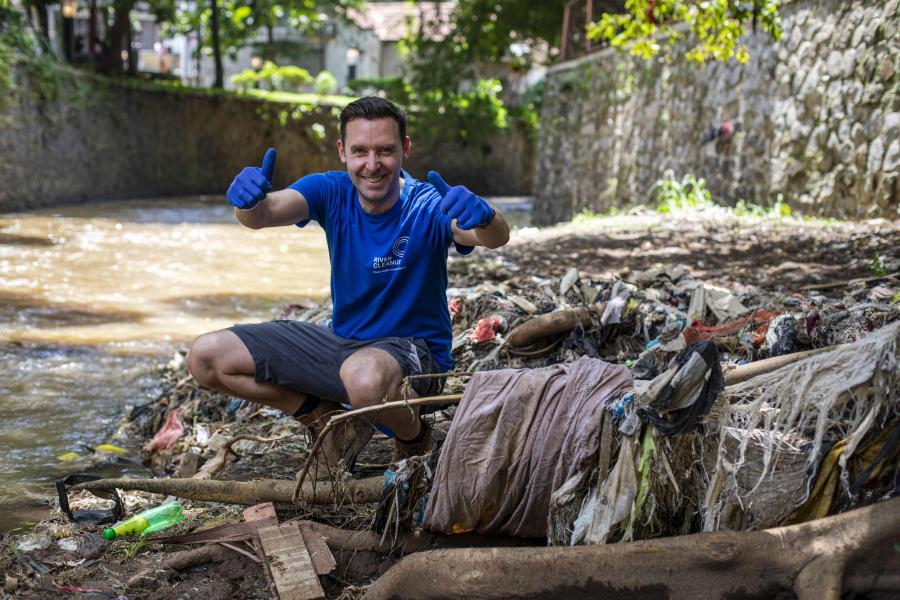Year of establishment
2019
Number of employees
11-50
Contacts

In 2017, I was challenged to pick up waste for 10 minutes, 10 days in a row. Little did I know how those 10 minutes would change my life. This is my story..
When my sister challenged me to pick up litter for 10 minutes I thought: "Seriously? Why should I pick up someone else's trash?". She even upped the assignment and challenged me to make a fun video out of it. So my children and I dressed up as superheroes, cleaned our whole street and… we had so much fun!
From that moment on, my awareness grew and the cleanups kept on coming. Once I saw the litter everywhere, I couldn't leave it. I started doing research and found out that over 8 billion kg of litter entered the ocean every year. This number has only grown since then.
A large part of that plastic ends up in the oceans through rivers. I decided to tackle the problem at the source and stop the plastic before it ever reaches the oceans.
People describe me as someone with an almost fatiguing energy level, contagious enthusiasm and the drive to succeed in anything I set my mind on. In 2018, I set my mind on making rivers plastic-free.
At first, I was just organizing cleanups and the amount of people wanting to help out was astonishing. Thousands of people joined our actions, all coming together to take care of our planet. A real community started to form.
The growing River Cleanup team quickly realized that we wouldn't reach our goals with cleanups alone. We started to work on education, spreading awareness, and working together with companies and governments to reduce plastic use.
Armed with the experience of the past few years and building upon the latest scientific insights, we returned to the drawing table in 2022 with one question: How can we make rivers plastic-free in the most effective and efficient way? Our answer: the ‘Clean River Model’. It’s an integrated approach with strategic interventions along the plastics value chain: from virgin plastic use reduction to circular economy solutions, preventing new plastic pollution and cleaning up legacy pollution.
By the end of 2025, we will prove the scalability of our model along 3 rivers. We expand to 100 rivers by 2030 and roll-out to 1 000 rivers by 2050. We know we can do it, but we must act now if we want our children and grandchildren to live happy, healthy lives. We are here to challenge the status quo, but we can’t do it alone. Reach out if you want to help us.
Together for clean rivers!
When my sister challenged me to pick up litter for 10 minutes I thought: "Seriously? Why should I pick up someone else's trash?". She even upped the assignment and challenged me to make a fun video out of it. So my children and I dressed up as superheroes, cleaned our whole street and… we had so much fun!
From that moment on, my awareness grew and the cleanups kept on coming. Once I saw the litter everywhere, I couldn't leave it. I started doing research and found out that over 8 billion kg of litter entered the ocean every year. This number has only grown since then.
A large part of that plastic ends up in the oceans through rivers. I decided to tackle the problem at the source and stop the plastic before it ever reaches the oceans.
People describe me as someone with an almost fatiguing energy level, contagious enthusiasm and the drive to succeed in anything I set my mind on. In 2018, I set my mind on making rivers plastic-free.
At first, I was just organizing cleanups and the amount of people wanting to help out was astonishing. Thousands of people joined our actions, all coming together to take care of our planet. A real community started to form.
The growing River Cleanup team quickly realized that we wouldn't reach our goals with cleanups alone. We started to work on education, spreading awareness, and working together with companies and governments to reduce plastic use.
Armed with the experience of the past few years and building upon the latest scientific insights, we returned to the drawing table in 2022 with one question: How can we make rivers plastic-free in the most effective and efficient way? Our answer: the ‘Clean River Model’. It’s an integrated approach with strategic interventions along the plastics value chain: from virgin plastic use reduction to circular economy solutions, preventing new plastic pollution and cleaning up legacy pollution.
By the end of 2025, we will prove the scalability of our model along 3 rivers. We expand to 100 rivers by 2030 and roll-out to 1 000 rivers by 2050. We know we can do it, but we must act now if we want our children and grandchildren to live happy, healthy lives. We are here to challenge the status quo, but we can’t do it alone. Reach out if you want to help us.
Together for clean rivers!
Location